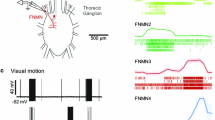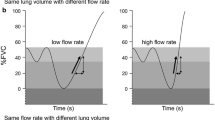Summary
Pigeons blown upon from in front were subjected to trapezoidal or stepped laterad neck flexions. The left-right response pattern of wing and tail muscles was regularly correlated with the direction of static neck flexion (Fig. 2). There was no difference whether the head or the body was deflected. In stepped neck flexions, the correlation between muscle activity and stimulus going in the on-direction was often greater than in the off-direction (Fig. 3, M. abd. ind.). Different muscles of the same pigeon frequently showed quite different stimulus-response relationships (Fig. 3 A and B). The muscle responses to steps of neck flexion were tonic (Fig. 2, M. abd. ind.), phasic-tonic (Fig. 2, 1. M. lat. caud.) or only phasic (Fig. 4C), and their time characteristics varied greatly. If not only the pigeon's breast but also its head was blown upon, the left-right activity of muscles depended on the flow direction relative to the head and on the direction of the head's yawing moment (Fig. 5). The left-right activity pattern of muscles was the same in forced and in spontaneous (active) head deflections (Fig. 6A); correlation between head-to-body angle and finger muscle activity was maximal at zero time displacement (±25 ms) between the two pigeon's outputs (Fig. 6B and C). We assume that there exist neck reflexes on wing and tail muscles which are ‘switched on’ when the pigeon is blown upon, and that these reflexes might act as a servo-mechanism which, as proposed by Groebbels (1929), causes the body to follow its beak during flight.
Similar content being viewed by others
Abbreviations
- EMG:
-
electromyogram
- M. abd. ind. :
-
M. abductor indicis
- M. ext. dig. :
-
M. extensor digitorum commuais
- M.ext. met. :
-
M. extensor metacarpi radialis
- M. lat. caud. :
-
M. lateralis caudae
References
Bendat JS, Piersol AG (1971) Random data: analysis and measurement procedures. Wiley and Sons, New York London Sydney Toronto
Biederman-Thorson M, Torson J (1973) Rotation-compensating reflexes independent of the labyrinth and the eye: neuromuscular correlates in the pigeon. J Comp Physiol 83:103–122
Bilo D (1974) Muskelaktivierung durch aperiodische horizontale Drehbeschleunigungsreize bei der Haustaube (Columba livia). J Comp Physiol 93:237–263
Bilo D (1977) Eingangs-Ausgangsbeziehungen und Modell eines Drehreflexes der HaustaubeColumba livia. Biol Cybern 26:109–124
Bilo D, Bilo A (1978a) Wind stimuli control vestibular and optokinetic reflexes in the pigeon. Naturwissenschaften 65:161–162
Bilo D, Bilo A (1978b) Einfluß von Windreizen auf vestibuläre und optokinetische Flügel- und Schwanzreflexe der Haustaube (Columba livia). Verh Dtsch Zool Ges 1978:263. Fischer, Stuttgart New York
Bilo D, Best G, Schönenberger J, Nachtigall W (1972) Zur Methode der Halothan-Inhalationsnarkose bei Vögeln. J Comp Physiol 79:137–152
Bilo D, Bilo A, Theis B, Wedekind F (1983) Activation of flight control muscles by neck reflexes in the domestic pigeon (Columba livia var.domestica). In: Varju D, Schnitzler HU (eds) Orientation and localisation in engineering and biology (Proceedings in life sciences). Springer, Berlin Heidelberg New York, in press
Bock WJ (1974) The avian skeletomuscular system. In: Farner DS, King JR, Parkes KC (eds) Avian biology, vol IV. Academic Press, New York London, pp 119–257
Delius JD, Vollrath FW (1973) Rotation compensating reflexes independent of the labyrinth: neurosensory correlates in pigeons. J Comp Physiol 83:123–134
Gewecke M, Woike M (1978) Breast feathers as an air-current sense organ for the control of flight behaviour in a songbird (Carduelis spinus). Z Tierpsychol 47:293–298
Groebbels F (1929) Der Vogel als automatisch sich steuerndes Flugzeug. Naturwissenschaften 17:890–893
Kasper J, Thoden U (1981) Effects of natural neck afferent Stimulation on vestibulo-spinal neurons in the decerebrate cat. Exp Brain Res 44:401–408
Lackner JR (1977) Induction of nystagmus in stationary subjects with a rotating sound field. Aviat Space Environ Med 48:129–131
Magnus R (1924) Körperstellung. Springer, Berlin
Manzoni D, Pompeiano O, Stampacchia G (1979) Tonic cervical influences on posture and reflex movements. Arch Ital Biol 117:81–110
McCouch GP, Deering ID, Ling TH (1951) Location of receptors for tonic neck reflexes. J Neurophysiol 14:191–195
Mergner T, Anastasopoulos D, Becker W (1982) Neuronal responses to horizontal neck deflection in the group × region of the cat's medullary brainstem. Exp Brain Res 45:196–206
Mittelstaedt H (1964) Basic control patterns of orientational homeostasis. Symp Soc Exp Biol 18:365–385
Mittelstaedt H (1982) Einführung in die Kybernetik des Verhaltens am Beispiel der Orientierung im Raum. In: Hoppe W, Lohmann W, Markl H, Ziegler H (eds) Biophysik. Springer, Berlin Heidelberg New York, 2. Aufl, pp 822–830
Oehme H (1976a) Die Flugsteuerung des Vogels. I. Über flugmechanische Grundlagen. Beitr Vogelkd Leipzig 22:58–66
Oehme H (1976b) Die Flugsteuerung des Vogels. III. Flugmanöver der Kornweihe (Circus cyaneus). Beitr Vogelkd Leipzig 22:73–82
Rabin A (1975) Labyrinthine and vestibulospinal effects on spinal motoneurons in the pigeon. Exp Brain Res 22:431–448
Richmond FJR, Abrahams VC (1979) What are the proprioceptors of the neck? In: Granit R, Pompeiano O (eds) Reflex control of posture and movement. Elsevier/North-Holland Biomedical Press, Amsterdam New York Oxford (Progress in brain resarch, vol 50, pp 245–254)
Roberts TDM (1978) Neurophysiology of postural mechanisms. Butterworth, London Boston Sydney Wellington Durban Toronto
Sy MH (1936) Funktionell-anatomische Untersuchungen am Vogelflügel. J Ornithol 84:199–296
Vidal PP, Roucoux A, Berthoz A (1982) Horizontal eye position-related activity in neck muscles of the alert cat. Exp Brain Res 46:448–453
Wenzel D, Thoden U (1977) Modulation of hindlimb reflexes by tonic neck positions in cats. Pflügers Arch 370:277–282
Wenzel D, Thoden U, Frank A (1978) Forelimb reflexes modulated by tonic neck positions in cats. Pflügers Arch 374:107–113
Woike M (1979) Der Flug fixierter Zeisige (Carduelis spinus L.) und seine Steuerung relativ zur Luft. Inaug-Diss. Düsseldorf
Author information
Authors and Affiliations
Rights and permissions
About this article
Cite this article
Bilo, D., Bilo, A. Neck flexion related activity of flight control muscles in the flow-stimulated pigeon. J. Comp. Physiol. 153, 111–122 (1983). https://doi.org/10.1007/BF00610348
Accepted:
Issue Date:
DOI: https://doi.org/10.1007/BF00610348




